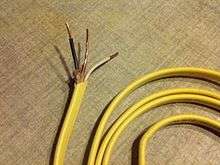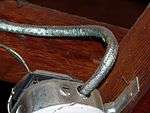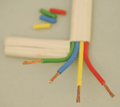Thermoplastic-sheathed cable

Thermoplastic-sheathed cable (TPS) consists of an outer sheath of polyvinyl chloride (PVC) insulation (the thermoplastic element) covering a "core" of one or more conductors of annealed copper. It is the most commonly used type of wiring for residential and light commercial construction in developed countries. In the UK and Ireland, the equivalent flat version of the cable is referred to as twin and earth. In mainland Europe, a round equivalent is more common.
Description
Each of the current carrying conductors in the "core" is insulated by an individual thermoplastic sheath, coloured to indicate the purpose of the conductor concerned. The Protective Earth conductor may also be covered with Green/Yellow (or Green only) insulation, although, in some countries, this conductor may be left as bare copper. With cables where the current carrying conductors are of a large Cross Sectional Area (CSA) and current carrying capacity, the Protective Earth conductor may be found to be of a smaller CSA, with a lower continuous current carrying capacity. The conductors used may be solid in cross-section or multi-stranded.
The type of thermoplastic, the dimensions of the conductor(s) and the colour of their individual insulation (if any) are specified by the regulatory bodies in the various countries concerned.[1]
Thermoplastic-sheathed cable cable is more vulnerable to rodent damage and accidental mechanical damage than wiring within electrical conduit or armored cable.
North America


In North America, this type of cable is designated as NM cable. NM means "nonmetallic", referring to the outer sheathing; the conductors are of course still metallic. The name "Romex" (a trademarked brand of the Southwire Company[2]) is commonly used generically for NM cable from any source.
In modern products, the color of the NM cable sheath (or jacket) indicates either the gauge of the current carrying conductors within it, or special properties of the sheathing itself. Cables found in older installations may not conform with this color coding.
The following are nominal current ratings for copper conductors; long runs may require thicker wires to minimize voltage drop.
- White: 14 AWG wire (2.08 mm2) for 15-amp circuits.
- Yellow: 12 AWG wire (3.31 mm2) for 20-amp circuits.
- Orange: 10 AWG wire (5.26 mm2) for 30-amp circuits.
- Black: 6 or 8 AWG wire (13.3 mm2 or 8.37 mm2) for 60- and 45-amp circuits, respectively.
- Gray: usage for underground installations, designated as "Underground Feeder" (UF) cables.[3]
The outer jacket is labeled with letters that show how many insulated wires are concealed within the sheath. However, this wire count does not include an uninsulated wire that is used as a ground wire, which may or may not be mentioned but is almost always present in modern cabling. For instance, if the cable lists "12-2 WG", it means there are two insulated 12-gauge wires (a black and a white wire), plus a ground wire. If the label says "12-3", this is a three-conductor, 12-gauge cable with a bare copper ground wire understood to be included.[4]
Australia and New Zealand
In Australia and New Zealand, the colour of the external sheath is usually white but several other colours are available. Wire sizes of from 1 mm² to 6 mm² Cross Sectional Area (CSA) are available with the outer sheath covering a "core" of either a single conductor, twin conductors, twin and earth conductors, or three and earth conductors. Although available in the larger sizes, solid conductors are rarely used with wire sizes greater than 1 mm² CSA, since the small extra expense of multi-stranded conductors is far outweighed by the relative ease of working with them, especially at the points of termination.
Unlike in North America, the existence of the Earth wire within the sheath is always specified if it is present (e.g. "Twin" cable has two conductors and "Twin and Earth" cable has three.) The earth conductor is always multi-stranded (unlike North American usage) and covered with Green/Yellow plastic insulation.
TPS is also often referred to as Tough Plastic Sheathed.[5][6]
Flat TPS is more common, and is used for fixed wiring of domestic and industrial lighting, power outlets and, also, for "hard-wired" appliances and heating and air conditioning units. Round TPS is less common, and is generally used only where cable glands are required. It may be more difficult to strip the outer sheathing from round TPS than from flat TPS.
 Flat "Twin and Earth" conductor TPS cable for single-phase plus earth
Flat "Twin and Earth" conductor TPS cable for single-phase plus earth Cross-section of same cable, showing three stranded inner wires
Cross-section of same cable, showing three stranded inner wires Flat "Three and Earth" conductor TPS cable for three-phase plus earth
Flat "Three and Earth" conductor TPS cable for three-phase plus earth Cross-section of same cable, showing four stranded inner wires
Cross-section of same cable, showing four stranded inner wires
See also
References
- ↑ Archived November 4, 2011, at the Wayback Machine.
- ↑ Barker, Bruce. "Old Wiring Methods". The ASHI Reporter. The American Society of Home Inspectors. Retrieved 2014-06-09.
- ↑ "Types of Electrical Wiring in Homes". Completeelectrical.biz. 2013-10-08. Retrieved 2015-03-03.
- ↑ "Nonmetallic Cable Sheathing Color Codes". Electrical.about.com. Retrieved 2015-03-03.
- ↑ "Australian Site - Flat TPS & SDI". Generalcable.com.au. Retrieved 2015-03-03.
- ↑ "Compliance of wiring materials in New Zealand homes and building". Level.org.nz. Retrieved 2015-03-03.